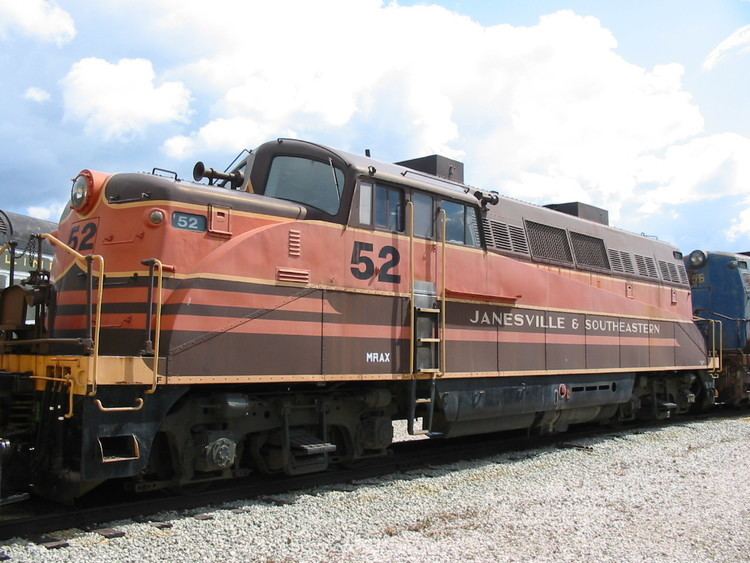Power type Diesel-electric Total produced 59 | Model BL2 AAR wheel arr. B-B | |
 | ||
Builder General Motors Electro-Motive Division (EMD) Build date September 1947 – May 1949 | ||
The EMD BL2 is a four-axle B-B road switcher built by General Motors Electro-Motive Division (EMD). Often considered the "Ugly Duckling" of diesel offerings from EMD, the BL2 led the way for the company's widely successful GP series of locomotives.
Contents
History
EMD's diesel program was well underway in the late 1940s and early 1950s, thanks to the success of the company's FT demonstrations across the country. While the F-units in production were great for moving trains over the railroad, their full-width carbody made it difficult for locomotive crews to see to the rear of the locomotive. This was considered a worthwhile sacrifice for a mainline locomotive, which was expected to do little switch work, since the full width carbody type was considered much more handsome and stylish, if lacking in the utility of the more functional looking switch engines, with their square lines, walkways and handrails, and narrow cowling covering their mechanical parts. The F-units also lacked locations for brakemen or switchmen to stand and ride short distances while performing switching duties, such as the fore and aft platforms, footboards and handrails provided on diesel switchers, which were too small and slow for road service. The F-units did have grab irons and stirrup steps, but these features were a hindrance in locations with tight clearances.
Since the engine inside the locomotive's hood didn't take up the full carbody width, it seemed only logical that the hood could be "cut away" a bit, leaning towards what was then more typically switch engine practice, to allow the crew to see the train more easily from inside the cab, and also to ride more safely outside the cab, but while hopefully retaining the style and looks of a full width carbody type. Thus, they created an early "road switcher", which combined the power and speed of a mainline "road" engine with the visibility and convenience of a switch engine, and which have since become ubiquitous on North American railroads. This wasn't an entirely new idea, as the Pennsylvania Railroad's GG1 fleet, which featured large cutout sections in its hoods, had been in service since 1934 (although without external riding platforms). Both the BL and GG series attempted to preserve the stylish appearance of a carbody unit, to make them suitable for passenger duty, but subsequent road switchers have adopted a purely utilitarian appearance, and are most often used for freight service.
Another problem facing EMD was that ALCO was making inroads into a market that EMD wanted to retain. ALCO's RS series road-switchers were starting to assume many of the tasks that EMD wanted to fulfill with their locomotives. Likewise, Baldwin and Fairbanks-Morse had started their own models of road-switchers.
EMD's designers and engineers designed a carbody somewhat reminiscent of the GG1 with mechanicals that contained the technical knowledge they had learned with the company's F-unit series. Starting from an F3, the result was the BL1 EMD Demonstrator #499 in September 1947. The BL1 Demonstrator was EMD Project 89499, thus the 499 Demonstrator number. The BL in the model name stood for "Branch Line", indicating that EMD felt the locomotive was best suited for light traffic and frequent switching chores.
The BL1 and BL2 were virtually identical, differing only in throttle mechanism. The only BL1 was built with an air-actuated throttle. The BL1 was converted to a BL2 in February 1948 by replacing the air-actuated throttle with a standard electrically-actuated throttle. The production BL2 used the standard electro-hydraulic governor and notched throttle as used in the F3. While EMD public relations claimed the difference between the BL1 and BL2 was a lack of Multiple Unit control, photographs of the BL1 demonstrator clearly show it was MU-equipped.
This locomotive was sold configured either for freight or passenger service. When configured as a passenger locomotive, it was equipped with a steam generator for heating the train; passenger versions can be identified by the exhaust stack of this generator, which protruded right in front of the windshield, between the two panes of glass. Freight units lack this stack.
Limiting the locomotive's success were several mechanical and ergonomic drawbacks. The mechanical components within the engine compartment were difficult to access and maintain, reducing its appeal among railroad shop crews. The locomotive's carbody lacked the full-length walkways of a true switch engine (a mistake not repeated on the subsequent "GP" series of diesels or other road switchers), making it difficult for the brakeman or switchman to move from one point on the locomotive to another during switching operations. Finally, although the industrial designers at EMD tried to build a carbody that evoked high-class passenger trains while retaining the utilitarianism of railroad work, the visual design never quite became popular. Even though the BL2 wasn't very successful, EMD's engineers learned much from the endeavor, and incorporated all of the good ideas from it into the company's widely successful GP series of locomotives.
Original owners
¹ The first six of the C&O units were actually ordered by the Pere Marquette Railway (PM), but were delivered after the C&O had purchased the PM. Units were delivered with C&O markings and PM lettering, leading to a myth that a handful were delivered before the merger with the PM.Preservation
The following BL2s have been preserved:
